Aquaporin 1 confers apoptosis resistance in pulmonary arterial smooth muscle cells from the SU5416 hypoxia rat model
- PMID: 39175041
- PMCID: PMC11341275
- DOI: 10.14814/phy2.16156
Aquaporin 1 confers apoptosis resistance in pulmonary arterial smooth muscle cells from the SU5416 hypoxia rat model
Abstract
Pulmonary hypertension (PH) arises from increased pulmonary vascular resistance due to contraction and remodeling of the pulmonary arteries. The structural changes include thickening of the smooth muscle layer from increased proliferation and resistance to apoptosis. The mechanisms underlying apoptosis resistance in PH are not fully understood. In cancer cells, high expression of aquaporin 1 (AQP1), a water channel, is associated with apoptosis resistance. We showed AQP1 protein was expressed in pulmonary arterial smooth muscle cells (PASMCs) and upregulated in preclinical PH models. In this study, we used PASMCs isolated from control male rats and the SU5416 plus hypoxia (SuHx) model to test the role of AQP1 in modulating susceptibility to apoptosis. We found the elevated level of AQP1 in PASMCs from SuHx rats was necessary for resistance to apoptosis and that apoptosis resistance could be conferred by increasing AQP1 in control PASMCs. In exploring the downstream pathways involved, we found AQP1 levels influence the expression of Bcl-2, with enhanced AQP1 levels corresponding to increased Bcl-2 expression, reducing the ratio of BAX to Bcl-2, consistent with apoptosis resistance. These results provide a mechanism by which AQP1 can regulate PASMC fate.
Keywords: cell death; lung; pulmonary hypertension; remodeling.
© 2024 The Author(s). Physiological Reports published by Wiley Periodicals LLC on behalf of The Physiological Society and the American Physiological Society.
Conflict of interest statement
None.
Figures
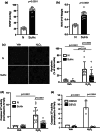
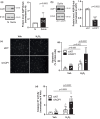
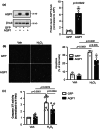
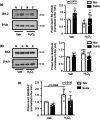
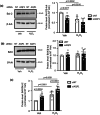
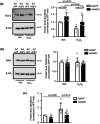
Similar articles
-
A novel interaction between aquaporin 1 and caspase-3 in pulmonary arterial smooth muscle cells.Am J Physiol Lung Cell Mol Physiol. 2024 May 1;326(5):L638-L645. doi: 10.1152/ajplung.00017.2024. Epub 2024 Feb 20. Am J Physiol Lung Cell Mol Physiol. 2024. PMID: 38375595 Free PMC article.
-
Hypoxia-induced migration in pulmonary arterial smooth muscle cells requires calcium-dependent upregulation of aquaporin 1.Am J Physiol Lung Cell Mol Physiol. 2012 Aug 15;303(4):L343-53. doi: 10.1152/ajplung.00130.2012. Epub 2012 Jun 8. Am J Physiol Lung Cell Mol Physiol. 2012. PMID: 22683574 Free PMC article.
-
Involvement of Gax gene in hypoxia-induced pulmonary hypertension, proliferation, and apoptosis of arterial smooth muscle cells.Am J Respir Cell Mol Biol. 2011 Jan;44(1):66-73. doi: 10.1165/rcmb.2008-0442OC. Epub 2010 Feb 16. Am J Respir Cell Mol Biol. 2011. PMID: 20160044
-
Divergent changes of p53 in pulmonary arterial endothelial and smooth muscle cells involved in the development of pulmonary hypertension.Am J Physiol Lung Cell Mol Physiol. 2019 Jan 1;316(1):L216-L228. doi: 10.1152/ajplung.00538.2017. Epub 2018 Oct 25. Am J Physiol Lung Cell Mol Physiol. 2019. PMID: 30358436 Free PMC article.
-
Aquaporin 1-mediated changes in pulmonary arterial smooth muscle cell migration and proliferation involve β-catenin.Am J Physiol Lung Cell Mol Physiol. 2017 Nov 1;313(5):L889-L898. doi: 10.1152/ajplung.00247.2016. Epub 2017 Aug 10. Am J Physiol Lung Cell Mol Physiol. 2017. PMID: 28798257 Free PMC article.
Cited by
-
[Application of Animal Models in Research on Hypoxia-Related Diseases].Sichuan Da Xue Xue Bao Yi Xue Ban. 2025 Mar 20;56(2):331-338. doi: 10.12182/20250360101. Sichuan Da Xue Xue Bao Yi Xue Ban. 2025. PMID: 40599265 Free PMC article. Review. Chinese.
-
Pulmonary Hypertension: Molecular Mechanisms and Clinical Studies.MedComm (2020). 2025 Mar 10;6(3):e70134. doi: 10.1002/mco2.70134. eCollection 2025 Mar. MedComm (2020). 2025. PMID: 40066229 Free PMC article. Review.
References
-
- Al Ghouleh, I. , Frazziano, G. , Rodriguez, A. I. , Csanyi, G. , Maniar, S. , St Croix, C. M. , Kelley, E. E. , Egana, L. A. , Song, G. J. , Bisello, A. , Lee, Y. J. , & Pagano, P. J. (2013). Aquaporin 1, Nox1, and Ask1 mediate oxidant‐induced smooth muscle cell hypertrophy. Cardiovascular Research, 97, 134–142. - PMC - PubMed
-
- Antonsson, B. , Conti, F. , Ciavatta, A. , Montessuit, S. , Lewis, S. , Martinou, I. , Bernasconi, L. , Bernard, A. , Mermod, J. J. , Mazzei, G. , Maundrell, K. , Gambale, F. , Sadoul, R. , & Martinou, J. C. (1997). Inhibition of BAX channel‐forming activity by Bcl‐2. Science, 277, 370–372. - PubMed
-
- Benito, A. , Silva, M. , Grillot, D. , Nunez, G. , & Fernandez‐Luna, J. L. (1996). Apoptosis induced by erythroid differentiation of human leukemia cell lines is inhibited by Bcl‐XL. Blood, 87, 3837–3843. - PubMed
-
- Bourgeois, A. , Lambert, C. , Habbout, K. , Ranchoux, B. , Paquet‐Marceau, S. , Trinh, I. , Breuils‐Bonnet, S. , Paradis, R. , Nadeau, V. , Paulin, R. , Provencher, S. , Bonnet, S. , & Boucherat, O. (2018). FOXM1 promotes pulmonary artery smooth muscle cell expansion in pulmonary arterial hypertension. Journal of Molecular Medicine (Berlin, Germany), 96, 223–235. - PubMed
MeSH terms
Substances
Grants and funding
LinkOut - more resources
Full Text Sources
Research Materials

